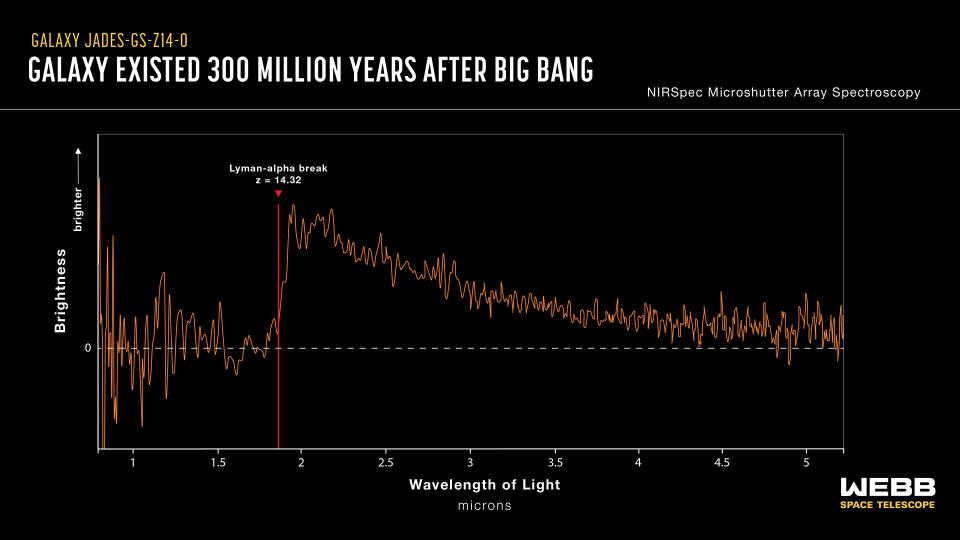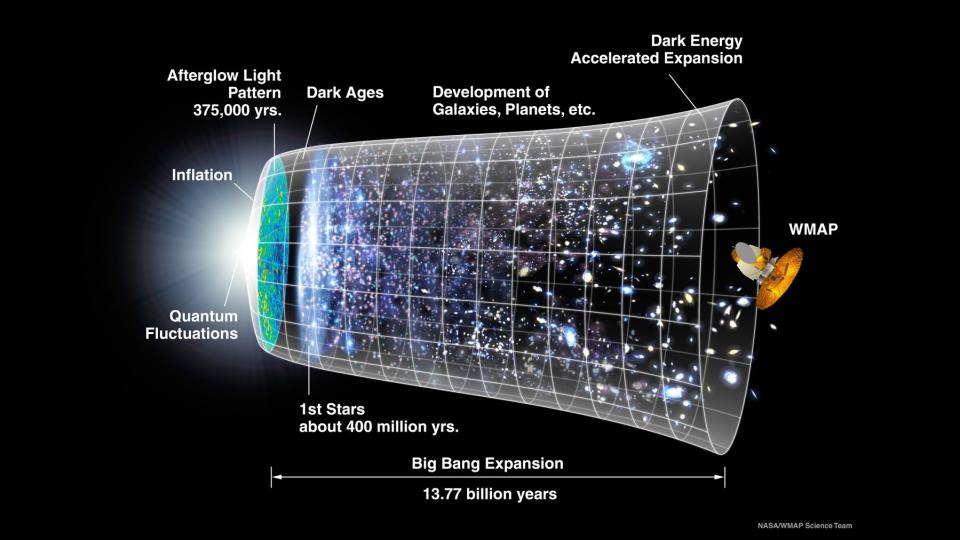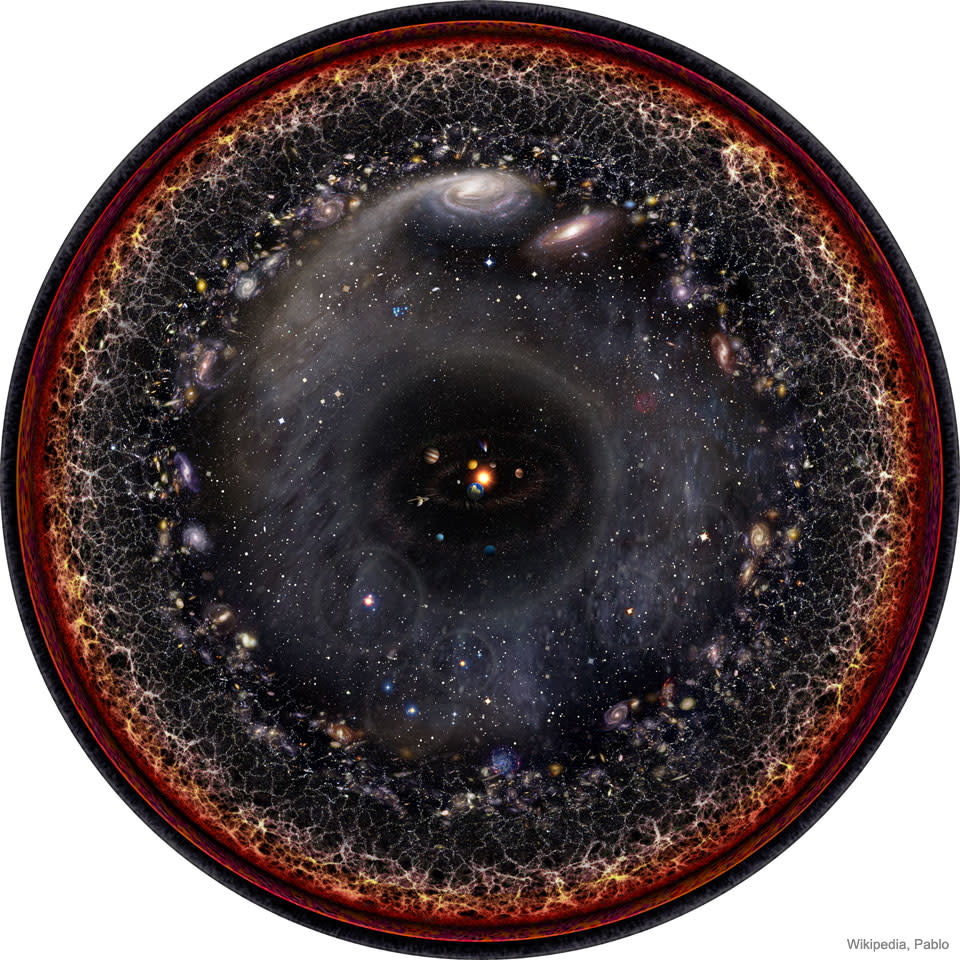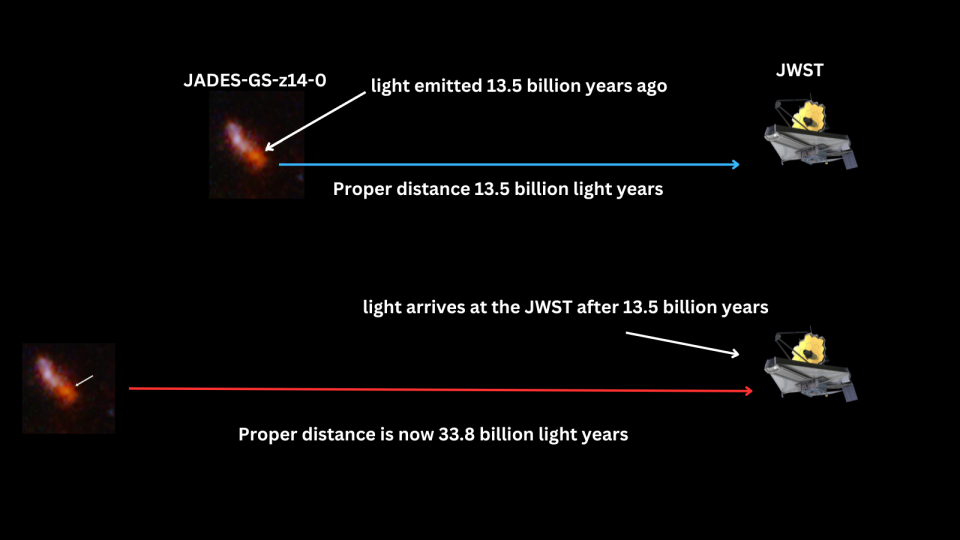The James Webb Space Telescope (JWST) has made a huge impact on astronomy since it began sending data back to Earth in 2022, and one of its most revolutionary achievements has been the observation of some of the most distant galaxies ever seen. But because light doesn’t travel instantaneously — instead, it travels at about 300 million meters (985 million feet) per second in a vacuum — we see these galaxies not as they are today, but as they were billions of years ago.
What’s more, our universe is estimated to be 13.8 billion years old. So we have to assume that the farthest galaxy we can hope to see is no more than 13.8 billion light-years away. (A light-year is the distance light travels in a year.) This point must be some kind of “cosmological horizon”—a point beyond which no telescope should be able to see. And since nothing can move through space faster than c, that means there shouldn’t be a galaxy more than 13.8 billion light-years away, and every day that goes by, it could have an effect on Earth. Right?
Wrong. If only the universe were that simple.

“The cosmological horizon is the maximum distance at which one can possibly obtain information,” Jake Helton, an astronomer at the University of Arizona and a member of the JWST Advanced Deep Extragalactic Survey (JADES) team, told Space.com.
“There are several different cosmological horizons,” Helton continued, “that have different definitions and depend on various cosmological quantities. The most relevant one here is the cosmological horizon, which is the maximum distance that light can reach us within the age of the universe. This
“The edge of the observable cosmos.”
Relating to: James Webb Space Telescope detects most distant galaxy ever seen (image)
In March 2024, JADES scientists announced that the powerful telescope had detected JADES-GS-z14-0, the most distant and earliest galaxy humanity has ever seen. But the paradox is that JADES-GS-z14-0 is located about 33.8 billion light-years away.
How can we see light from an object so distant that the universe is not old enough to reach us? Doesn’t JADES-GS-z14-0’s location at 33.8 billion light years away mean that we are seeing it as it was 33.8 billion years ago? Something that would certainly challenge estimates of the age of the universe?
No, it is not. Again, this is proof that the universe has a habit of overturning logical and reasonable outcomes.
“How can a distant galaxy like JADES-GS-z14-0 be observed when it is 13.8 billion light-years away and its light appears to have taken longer than the age of the universe to reach us?” Helton asked rhetorically. “The answer is that the universe is expanding.”
Seeing a galaxy older than time itself
If the universe were to stand still, it would take light from a galaxy 33.8 billion light-years away 33.8 billion years to reach us, and that’s it. However, in the early 1900s, Edwin Hubble discovered that distant galaxies appear to be moving away from each other, and the farther apart they are, the faster they move. In other words, the universe is not static; it is expanding.
This situation got even more complicated in 1998, when two separate teams of astronomers observed that the universe was not only expanding, but that the expansion was accelerating, at the end of the 20th century. The force responsible is a mystery, but it has been given the tentative name “dark energy.”


There have been two major and distinct periods of expansion during the 13.8 billion year history of the universe. The first is the initial period of rapid cosmic inflation, now commonly referred to as the “Big Bang”.
During this period of inflation, the volume of the cosmos increased by a factor of 10^26 (10 with 25 zeros after it). This is equivalent to your fingernail growing at a rate of 1 nanometer per second, suddenly becoming 10.6 light-years (62 trillion miles) long. During this period, the universe was ruled by energy and this period is known as the energy-dominated period.
This was followed by a matter-dominated period starting 47,000 years after the Big Bang. Eventually, cosmic expansion cooled the cosmos enough for protons to form from quarks and gluons, which then bonded with electrons to form the first hydrogen atoms, which in turn formed the first stars and galaxies. During this period, the expansion of the universe, driven by the Big Bang, came to a near standstill.
The period when matter dominated came to a surprising end when the universe was just under 10 billion years old. At that time, the universe suddenly began to expand rapidly again. And this expansion accelerated and continues to accelerate even today. This third major period of the universe is called the period dominated by dark energy. It is the period we are currently in.


Thanks to these periods of expansion of the universe, the light from JADES-GS-z14-0 has actually been traveling toward JWST and Earth for only about 13.5 billion years, even though its source is now much farther away than 13.5 billion light-years away. This means that JWST sees JADES-GS-z14-0 as it was 300 million years after the Big Bang. Without the expansion of the universe, JADES-GS-z14-0 would still be about 13.5 billion light-years away, but it would still experience smaller local motions that would pull it closer to or farther away from nearby galaxies. But such galactic motion would be nothing close to the kind caused by the expansion of the universe.
According to Helton, the cosmological horizon, or “Photon Horizon”, is a sphere with a boundary of about 46.1 billion light years away, a figure determined by the expansion of the universe. This is the true horizon beyond which we should not “see” a galaxy. The galaxy JADES-GS-z14-0 is indeed within this horizon.
To avoid confusion, astronomers actually use two distance measurement scales: a co-motion distance, which eliminates the expansion of the universe as a factor, and a proper distance, which includes it. This means that the co-motion distance of JADES-GS-z14-0 is 13.5 billion light-years, while its proper distance is 33.8 billion light-years.
But JADES-GS-z14-0 and other distant and old galaxies won’t always be visible.


It’s a lucky time to have the James Webb Space Telescope
The fact that JWST can see JADES-GS-z14-0 means that it was once “causally connected” to Earth and our local universe. In other words, it was possible for a signal from JADES-GS-z14-0 to reach us in the Milky Way, so a “cause” that existed in that galaxy at the beginning of time could have an “effect” in our galaxy in this modern era of the cosmos.
“Any observable galaxy must be within the particle horizon and must be causally connected to us at some point in the history of the universe,” Helton said.
But that’s no longer the case. Galaxies like JADES-GS-z14-0 and others discovered by JADES are now so far away, and are moving away from us so fast thanks to dark energy, that no signal sent from them today would reach us. This is because the photon horizon is moving away from us at the speed of light, but Really Distant objects, the space between the Milky Way and these galaxies is expanding Faster faster than the speed of light.
This may seem counterintuitive, since Albert Einstein’s theory of special relativity sets the speed of light as a universal speed limit, but it’s a rule of thumb for moving objects with mass. from beginning to end space is not a rule about the texture of space.
RELATED STORIES:
— James Webb Space Telescope observes record-breaking ‘failed star’ that shouldn’t exist (video)
— Volunteers detect nearly 100 cool brown dwarfs near our sun
— ‘Failed star’ is coldest radio wave source ever discovered
About 2 trillion years after Earth and humanity are long gone, the expansion of the universe means that any intelligent species that would replace us in the Milky Way (if they ever do) will not be able to see any galaxies that exist beyond our local group, which is about 10 million light-years in diameter.
It’s a sobering thought, and it means that humanity lives at a unique point in the history of the universe where the most distant galaxies are still within our sights. We have the capacity to know more about the universe and its origins than any intelligent life that might follow us. Astronomers, including Helton, aim to use JWST to fully exploit this cosmic privilege.
“Working with JWST and the JADES Collaboration has been incredible,” Helton said. “Writing articles about science with JWST has been a great experience, as I recently wrote
JADES-GS-z14-0 has been the most rewarding and exciting experience
“My research career.”